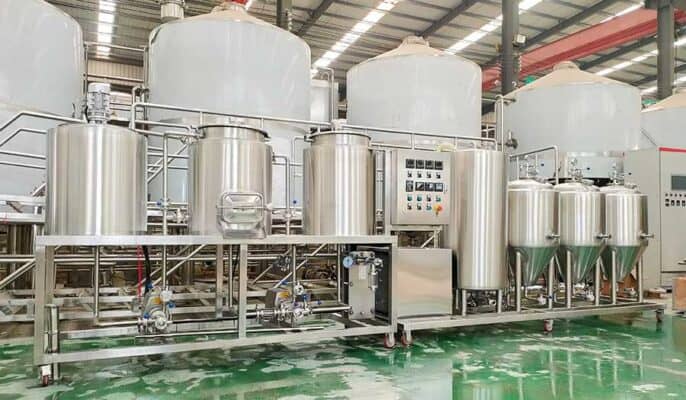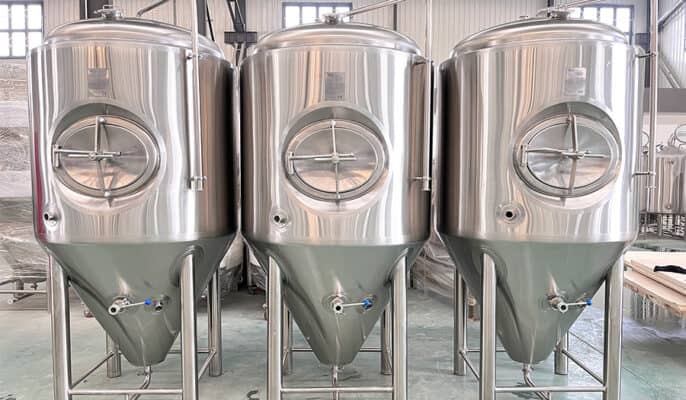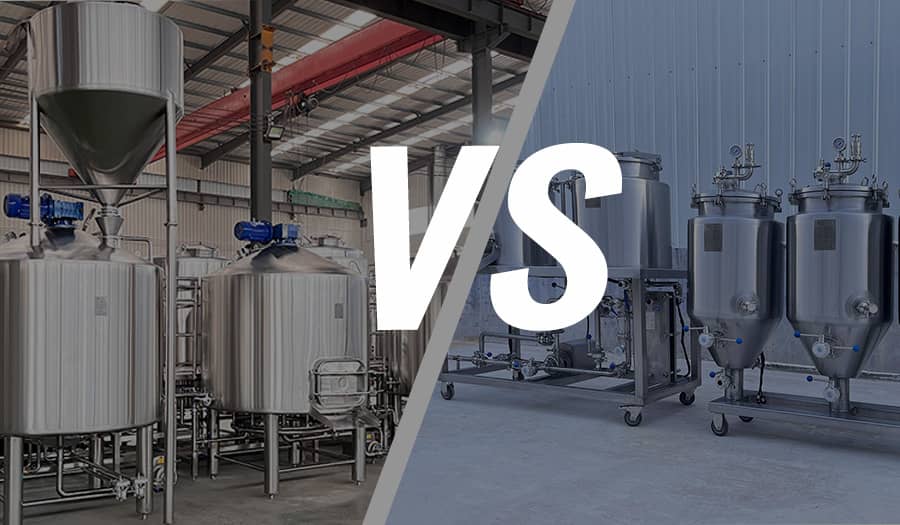홈 브루어와 전문 브루어 모두 사용하는 단계와 재료는 동일합니다. 가정용 양조 장비와 상업용 양조장 장비는 서로 다른 생산 규모에 맞게 설계되었으며 서로 다른 특징과 기능을 가지고 있습니다. 오늘의 블로그를 읽어보시면 홈 브루잉과 상업용 브루잉 사이에는 많은 유사점과 차이점이 있다는 것을 알게 될 것입니다.
다양한 정의
홈 브루잉이란 무엇인가요?
홈브루잉은 집에서 맥주, 미드 또는 사이다를 양조하는 소규모 양조 애호가를 말합니다. 이들은 보통 집에서 취미로 맥주를 양조하며 다른 사람에게 판매하지 않습니다.
상업용 양조장이란 무엇인가요?
상업 양조는 기업이나 양조장에서 맥주나 다른 종류의 술을 양조하는 것을 말합니다. 상업용 와인 제조업체는 양조한 와인을 소비자나 도매상에게 판매하여 수익을 창출합니다.

생산 규모가 다릅니다.
곡물을 으깨고, 홉을 넣고, 맥즙을 발효시키고, 맥주를 숙성시킨 후 병에 담는 등 대부분의 양조 과정은 상업용 양조와 가정용 양조 모두 동일합니다. 가장 큰 차이점은 상업용 양조장이 가정용 양조장보다 더 많은 맥주를 생산할 수 있다는 것입니다.
가정용 양조 장비는 1~10갤런(3.8~38리터)의 배치 크기로 소규모 생산을 위해 설계되었습니다. 반면 상업용 양조장 장비는 배치당 수백에서 수천 갤런(수천에서 수만 리터)을 생산하는 대규모 생산용으로 제작되었습니다.
포뮬러 원료가 다릅니다.
홈브루어들은 자신의 취향에 따라 독특한 맥주 레시피를 자유롭게 만들 수 있습니다. 다양한 재료와 스타일의 조합을 실험하여 다양한 맛과 향을 만들어낼 수 있습니다. 반면 상업용 양조장은 계절 맥주나 한정판 맥주를 제공하기도 하지만 몇 가지 대표 맥주와 기존 스타일을 고수합니다.
상업용 양조장은 전 세계에서 재료를 구매할 수 있는 자원이 있기 때문에 홈브루어리보다 더 다양한 재료를 사용할 수 있는 경우가 많습니다. 즉, 상업용 양조장에서는 신선한 홉과 같은 더 비싼 재료를 사용할 수 있어 맥주에 더 복잡한 풍미를 줄 수 있습니다. 그러나 홈브루어들은 종종 구할 수 있는 재료에 제한을 받기 때문에 양조할 수 있는 맥주의 종류가 제한될 수 있습니다.
다양한 추출 장비 필요
홈 브루잉은 많은 장비와 도구가 필요하지 않으며, 샘플 병이나 버킷 몇 개만 있으면 1~5갤런의 고품질 맥주를 생산할 수 있습니다. 하지만 상업용 양조는 다른 이야기입니다. 소규모 양조장도 복잡한 장비, 원자재, 유틸리티를 많이 구입해야 합니다. 맥주 생산량이 증가함에 따라 특수 장비가 필요할 수도 있습니다. 이러한 장비는 가정용 양조 장비와 동일하지만 훨씬 더 큽니다.
소규모 양조장을 시작하기 위해 필요한 체크리스트는 다음과 같습니다:
- 양조장 장비(주전자, 보일러)
- 발효 탱크 그리고 밝은 탱크
- 필터
- 냉각 시스템
- CIP 클리닝 시스템
- 파이프라인
- 충진 또는 병입 장비
- 공급: 홉, 맥아, 효모, 병, 라벨 및 포장.
- 유틸리티: 전기, 증기 및 수도 등
프로세스가 다릅니다.
상업용 양조장은 이러한 장비에 투자할 여력이 있기 때문에 가정용 양조장보다 자동화된 공정을 더 많이 사용합니다. 자동화된 프로세스는 오류가 발생할 가능성이 적기 때문에 보다 일관된 제품을 생산할 수 있습니다. 홈 브루어리는 보다 수동적인 공정을 사용하므로 양조 과정을 더 잘 제어할 수 있습니다. 하지만 사람의 실수가 발생할 여지가 더 많기 때문에 최종 제품에 더 많은 변수가 발생할 수 있습니다.

효율성이 달라집니다.
상업용 양조장 장비는 효율성에 최적화되어 있으며 가장 비용 효율적인 방식으로 일관된 품질의 맥주를 대량으로 생산하도록 설계되었습니다. 여기에는 급속 냉각을 위한 열교환기, 대용량 보일러, 고효율 여과 시스템과 같은 기능이 포함됩니다. 가정용 양조 장비는 규모가 작고 실험과 개인적인 즐거움에 초점을 맞추기 때문에 동일한 수준의 효율성이 우선시되지 않을 수 있습니다.
상업용 양조에 대한 제약
일반적인 홈브루어리와 상업용 양조장의 가장 큰 차이점은 상업용 양조장의 제약이 있다는 점입니다. 홈브루잉의 가장 큰 장점은 원하는 맥주를 마음껏 양조할 수 있다는 것입니다. 상상의 양조 레시피가 밝혀지면 버릴 수 있고 $20만 잃을 수 있습니다. 하지만 상업용 양조장에서 배치당 최소 3배럴의 맥주를 생산한다면 여전히 버려야 하고 수백, 수천 달러의 손해를 보게 됩니다. 어느 순간 상업 양조로 전환하면 크리에이티브 라이선스를 잃게 됩니다. 물론 많은 양조장에는 소량 시험 양조를 전담하는 양조 전문가가 있을 것입니다. 맥주 스타일과 맛이 요구 사항을 충족하는 경우에만 대량으로 양조할 수 있습니다.
여과 및 저온 살균
상업용 맥주는 맥주에서 효모와 박테리아를 제거하고 유통기한을 연장하기 위해 여과 및 저온 살균 과정을 거칩니다. 상업용 맥주 양조장에서는 많은 사람들에게 맥주를 판매할 수 있어야 하고 맥주가 진열대에서 신선하게 유지되도록 해야 하기 때문에 이러한 작업을 수행합니다.
홈브루 맥주는 여과하거나 저온 살균하지 않기 때문에 더 신선하고 풍미가 풍부합니다. 하지만 홈브루 맥주는 유통기한이 짧기 때문에 빨리 소비해야 한다는 단점도 있습니다.
장비 청소 방법이 다릅니다.
맥주 생산 과정에서 맥주 양조 장비는 청결하게 유지되어야 합니다. 먼지가 없어야 할 뿐만 아니라 박테리아도 없어야 합니다. 홈브루어들은 표백제와 세제를 사용해 장비를 청소하고 소독제를 사용해 박테리아 수를 조절합니다. 홈브루잉 장비가 색이 바래거나 마모되었거나 긁힌 경우 다른 홈브루잉 장비로 교체해야 합니다. 상업용 양조장에서는 위에서 언급한 방법을 사용하여 장비를 청소해야 할 뿐만 아니라 부식성이 강한 여러 가지 화학 물질을 사용하여 세척하고 살균해야 합니다.
어떤 방법이 더 적합할까요?
홈 브루잉과 상업용 브루잉은 맥주의 맛은 비슷할 수 있지만, 맥주를 완성하는 과정은 실제로 다릅니다. 두 맥주 모두 각자의 장점이 있기 때문에 선택하기가 조금 어려울 수 있습니다.
다음 요소가 도움이 될 수 있습니다:
- 개인 취향과 건강 목표. 어떤 사람들은 홈메이드 음료의 맛과 향, 추가 비타민 함량을 선호하는 반면, 어떤 사람들은 시판 음료를 구매하는 것이 더 안전하다고 느낍니다.
- 홈 브루잉 방법, 기술 및 위생. 기준을 충족하지 못하면 제품이 변질될 수 있습니다. 유지하면 양질의 제품을 생산할 수 있습니다.
- 상업용 맥주 비교. 집에서 만든 맥주를 어떤 상업용 맥주와 비교하시겠어요? 영양 성분은 어떤가요? 칼로리 함량은? 알코올 함량은?
어느 쪽을 선호하든 혼란스러울 때 도움이 되길 바랍니다.





안녕하세요, 간단히 알려드리고 몇 가지 사항을 알려드리고자 합니다.
사진이 제대로 로드되지 않습니다. 이유는 잘 모르겠지만 연결 문제인 것 같습니다.
두 가지 다른 웹 브라우저에서 시도해 보았습니다.
은 동일한 결과를 표시합니다.
안녕하세요! 이 게시물에 제공해주신 훌륭한 정보에 큰 박수를 보내드리고 싶습니다.
조만간 웹사이트를 다시 방문해 더 많은 소식을 전해드리겠습니다.